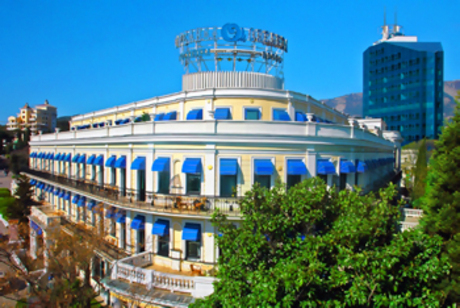Oreanda Palace
The construction of the Palace for Empress Alexandra Fedorovna, spouse of Emperor Nikolay I, began in 1842 by famous acrhitect Andrey Schtakenschneider.
Today we can't imagine all the splendour of this Palace as it was burnt up in 1882 and never re-edified. The Palace was 2 storied high, in Classic style, had the Atrium and resembled Belveder (in Peterhof).
There is no detail info or pictures of the interiors, all is khown that the finery was in Pompeian (Greek) architectural style. Since 1860 year grand duke Konstantin Nikolayevitch became the owner of the Palace he personally fought a fire in 1882. Grand Duke did not have enough money for reconstruction of the burnt-to-ashes Palace and just decided to build a church near the ruins. After the WW II the ruins were demounted and in 1948 on the place was built a health resort.
The name is a debatable subject although there is no reason to doubt that it is a mispronounced name of Oreade - a nymph of mountains and grottoes in the mythology of Ancient Greece. In the autumn of 1825, Alexander I took his dying Empress for a change of air to the Oreanda Estate. Everything betokened a serene life, but Alexander I died at Taganrog on November 1825, "crushed", to use his own words, "beneath the terrible burden of a crown". The Empress died in St. Petersburg in May, 1826.
In 1837, Nicholas I visited Yalta. Due to his visit the development of the townlet was changed greatly. A general plan of the development of Yalta was drawn up and it was passed by the Emperor. And in 1838, by the order of Nicholas I, Yalta became a city and a centre of a separate uyezd (lowest Russian administrative division). The august couple visited the Imperial residence in Oreanda and Alexandra Fyodorovna liked it very much. It was decided to build a palace there for her to take summer rest and treatment, and the German architect Karl Friedrich Schinkel was assigned the task. He submitted a magnificent design in which Grecian motifs were applied to picturesquely irregular composition, where architecture and nature luckily collaborated. Schinkel's inventiveness as an architect was truly amazing but it turned out that it would be impossible to put the project into effect because of the tremendous work of construction and, accordingly the enormous expense. With this problem in view Andrei Staken-schneider, one of the leading architects of St. Petersburg, made considerable alterations to the original design. The designed building was smaller in scale but it did not lose any of Schinkel's imposing magnificence.
In 1852 the construction of the palace was completed and in autumn Nicholas I and his family spent the mellow season in Oreanda, enjoying the southern climate, a simple mode of life and perfect rest. However, this was their first and only season to stay there. The defeats in the Crimean War (1853-1856) became the prologue of the revelation of Nicholas I's failures and broke the spirit of the Emperor, who, on February 18, 1855, did away with his life. After Alexandra Fyodorovna's death in 1860, in accordance with her testament, the Oreanda Estate went to her second son, Grand Prince Constantine Nikolayevich, the younger brother of the future Emperor Alexander III.
The Oreanda Estate had lost the statute of a hereditary property of the Imperial family up to 1894. Grand Prince Constantine Nikolayevich, an admiral and distinguished military specialist, was in charge of the Russian fleet during the exercises as the Minister of the Navy. He was the leader of the liberal movement in favour of moderate democratic reforms, advocating the principles of "a revolution on top", which resulted in a number of reforms enacted by his regal brother in the 1860s-70s.
After the assassination of Alexander II on March 1, 1881 and the assertion on the throne of Alexander II's son, Alexander III, a supporter of a more conservative policy. Grand Prince Constantine Nikolayevich was removed from almost all high posts. Misfortunes never come singly. On the night of August 7-8, 1881, as ill luck would have it, the palace took fire and the conflagration that lasted for several hours destroyed the palace. Its ruins and columns, looking like some Greco-Roman ones, remained untouched for years, lending charm to the beautiful Oreanda park.
For the rest of his life Constantine Nikolayevich and his wife Grand Princess Alexandra losifovna longed to spend much of their time in Oreanda running the estate. They were also constantly engaged in charity and patronage. The Grand Prince supervised the construction of the Church of the Protecting Veil of the Mother of God in Oreanda designed by architect Alexis Avdeyev.
You will remember, "At Oreanda they (Anna Sergeyevna and Dmitry Gurov - Tr.) sat on a bench not far from the church, looked down at the sea and were silent. Yalta was hardly visible through the morning mist, white clouds stood motionless at the mountain-tops. The leaves did not stir on the trees, grasshoppers chirruped, and the monotonous hollow sound of the sea rising up from below spoke of. the peace, of the eternal sleep awaiting us." (Anton Chekhov, The Lady with a Dog) In September 1894 the Oreanda Estate was bought by the crown for Alexander III, but intensive construction work was never again conducted in Oreanda.
Nowadays there is a hotel named Oreanda at the same place as the palace. You can get there by direct flight to Simferopol or through Kiev or Odessa.



